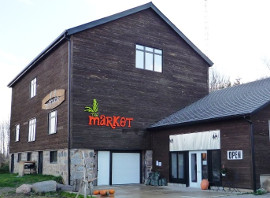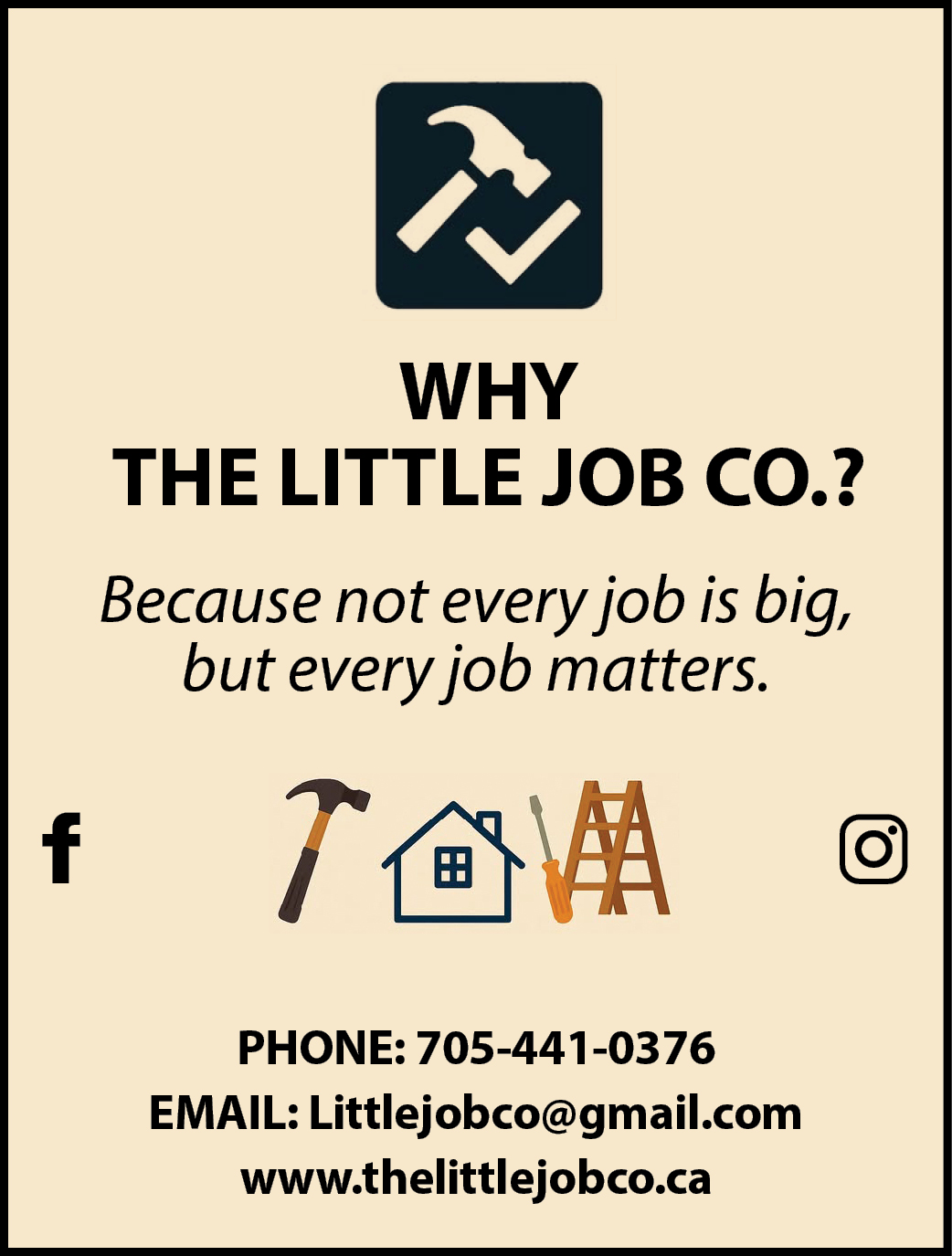Bill Monahan
 Meaford’s Barn Cooperative, an eye-catching landmark on Highway 26 at the east end of Meaford, has ambitions to meet the challenges of our present and future world with a new business model that, in the words of Chairwoman Candice Newmaster, is “pre-emptive and sets in place systems that protect what we have and encourage us to go back to a higher quality of living.”
Meaford’s Barn Cooperative, an eye-catching landmark on Highway 26 at the east end of Meaford, has ambitions to meet the challenges of our present and future world with a new business model that, in the words of Chairwoman Candice Newmaster, is “pre-emptive and sets in place systems that protect what we have and encourage us to go back to a higher quality of living.”
It is this higher quality of living that the originators of cooperative marketing organizations set out to achieve when they first appeared in Canada in the 1840s, inspired by the movements in England that had sprung up in response to the negative impact that the Industrial Revolution had on local manufacturers and consumers.
The model for all subsequent co-ops originated in 1844 with the Rochdale Society of Equitable Pioneers in an English village. Flannel makers and weavers, along with associated trades and businessmen, had been displaced by the large factories. They banded together for survival and took as their guide the writings of Robert Owen.
Owen had made a fortune with his cotton factories and wasn’t blind to the impact of economic change upon the displaced and disenfranchised tradespeople, who had up to then been valued contributors to the economy. He had the idea of forming ‘villages of co-operation’, where workers would drag themselves out of poverty by growing their own food, making their own clothes, and ultimately becoming self-governing. He tried to create such a village in Scotland, and another later in the USA but both failed. There was one that didn’t – the flannel makers of Rochdale, who followed his guide and also added their own rules to the governance of a cooperative society to finally create a model that would and did last.
Writer Jennifer Wilhoit, in Cultural Survival Quarterly Magazine, wrote that, “…with the emergence of mass production during this time, entrepreneurs who had previously been capable of the sustainable production of high quality goods found themselves competing with large industries that sold less-expensive, poorly made products. In the tea industry, for example, large-scale producers added grass clippings to bulk up tea, sacrificing quality for quantity. Production was changing in order to accommodate consumers’ desire for cheaper, plentiful goods. Those who rapidly produced high volumes could meet the demands of the shifting market.”
The producers, processors, service providers and consumers who make up The Barn Cooperative meet similar challenges today.
The Barn came into existence when the building was being sold and the local organic market on the main floor was threatened. An inspired group of young entrepreneurs used the Rochdale model, with a goal, as Candice Newmaster says, of economic independence.
 “The consumer needs to have independence and economy in their ability to access products, specifically food but also services,” she explained. “We as the Board of Directors and founding members found that there was a lack of diversity in options in our current food system. We really wanted to create a place where we could encourage small producers to be able to access the consumer markets. In that way they support the local economy and also support diversity for the consumers.”
“The consumer needs to have independence and economy in their ability to access products, specifically food but also services,” she explained. “We as the Board of Directors and founding members found that there was a lack of diversity in options in our current food system. We really wanted to create a place where we could encourage small producers to be able to access the consumer markets. In that way they support the local economy and also support diversity for the consumers.”
The idea of a cooperative business model has worked well in the past with many successes through the years. It is democracy in action in the marketplace. Since the Rochdale Society there have been successful co-ops that have provided alternatives to banks and insurance companies, have helped to get western Canadian grain to market, put in telephone lines, advocated for women’s suffrage, and built green energy grids. They continue to thrive in many forms today.
The Barn is about food. Quality food at reasonable prices.
As Candice stated, “One of the reasons why The Barn Cooperative was founded in the beginning was from a group of people that really wanted to see free access to the market.
“At our core we’re about integrity and quality of our products. That’s part of supporting the small producers that are really working towards bringing quality back.
“[This concept is] tricky because it seems like the products are more expensive but actually it’s about trying to bring back a realistic approach to our food system.
She explains, “A three part approach to quality. We have the board members there to make sure that everything adheres to that principle of quality and integrity. Staff members do as well and so does the community, so we have everybody working to ensure the quality of our products.
“Part of the beauty of having as many local products as possible in our facility is that we have that direct relationship with our producers so that we know they’re making enough money and we also know that they’re adhering to the principles of quality.”
The Barn is also about unique services and educational opportunities.
Their Mission Statement reads in part: “To facilitate the growth of a healthy community, and to integrate traditional sustainable knowledge into our offerings, providing education in all that we undertake.”
Members receive a weekly e-newsletter displaying a varying program that includes yoga, meditation, healthy eating demos, understanding Chinese medicine, medicinal cannabis demos, wild food demos and more. There’s always a wide-ranging, ever-changing flow of events, and it all happens around the practitioners and artisans that provide the services and products to keep the co-op going and growing.
“By creating a multi-faceted dynamic approach to the business it allows it to be viable in a small community,” said Candice. “The diversification and bringing holistic products and services together into one place and working together allows all the different businesses that happen within The Barn to be viable. When they’re all separate and individual in different locations it’s a little bit trickier. We create a one stop shop for that demographic.”
With the great variety of community-enriching activities that go on at The Barn, including the legendary open mic on Sunday afternoons that brings musicians from miles around, it’s worth remembering that The Barn Cooperative, in keeping with all co-ops through history, is a business.
“We are a for-profit cooperative, but the money that we make after we put money into reserves, pay the investors their dividends, and invest into building the business, goes back to the consumers in the form of a patronage return.
“What that is,” Candice explains, “it’s based on how much they spend so they’ll get a percentage of the profits based on how much they’ve consumed. Mountain Equipment Co-op is a similar model where they will hand out patronage returns if they have a profit. At the end of the year – I think we set it up so that it’s at Christmas – we will hand out the patronage returns to consumer members. Each member has an account with us and we can see how much they’ve spent over the whole year, and then we divide up the profits.”
The mention of investors at the top of the benefits chain raises the spectre of the profit motive becoming paramount. That is the great fault of our capitalist society in which investor greed motivates every action. But Candice explained that the co-op is managed by its members, not by a drive for dividends.
“An investor is not required to be a member of The Barn cooperative, their investment is called a ‘preference share’. There’s no liability associated with it other than the fact that they are investing their money. If there’s a profit they’ll get a 5 to 5.25% dividend, if there is not a profit, that dividend is recorded and paid when there is a profit.
“The investors don’t actually have a say in the business. Unless they want to be a member, they don’t actually have a vote. Each investor, if they were a member, would only have one vote. It’s a simple 5 or 5.25% dividend depending on what level of share and that’s it. So it allows people to invest into the cooperative model in the community but it remains completely democratic.”
And it’s a business model that thrives as it helps the local community to thrive.
“For me, mainly, it’s about creating a system that brings as much money as possible back into the community. That’s by taking out as many middlemen as possible and again facilitating access to the market by small producers. That’s the goal.”
Candice admits there are challenges.
“It’s really hard in the beginning, especially in the first few years, trying to develop a viable and vibrant business. That process makes it tricky for us to really be competitive with big grocery stores, even in the organic sector. We have large overheads and we have to build up our capital.
“A lot of the challenges we face are from the fact that we aren’t able to provide a drop-down corporate structure that is already finished and perfected. There are a lot of imperfections and inefficiencies in the beginning as we work on fine-tuning our process and the structure of our business. We’re getting very close and I believe that in the next three years we will be in a position where we will begin to run with larger profits. This will allow us to be able to give back to the community more and provide products at a lower cost.”
She and the other managing members of The Barn Cooperative see an even brighter future. They continue to reach out to form relationships with other cooperatives, doing their banking at Meridian, which is a cooperative credit union, and developing a partnership with Eat Local Grey Bruce, a food distribution cooperative. “That way we can work with another existing operation as opposed to duplicating it, and we facilitate delivery of some of The Barn’s products to the consumers’ homes/pickup locations across Grey, Bruce, and Huron Counties, and at the same time access stronger buying power because we work together.”
The Barn is in the process of creating a business model that has implications for rural Canada.
“The Barn is multi-faceted. A lot of facilities like The Barn, mainly focused around food, happen in larger city centres. But there’s often not enough of a market to have just a food cooperative in smaller communities. By creating a multi-faceted and dynamic approach to the business it allows it to be viable in a small community.”
“As the population becomes more spread out and moves from the big city centres, there becomes a greater need for models like The Barn in rural areas. It also supports local producers to have a place where they can sell their products rather than shipping it all the way down to Toronto. It allows consumers to have access to holistic products and services where otherwise they might not.”
Serving the interests of local producers of food and products while contributing directly to the community with education and fair prices for quality goods – these stood out as the founding values of the Rochdale Pioneers. They form the foundation of The Barn Cooperative as well.
Local producers or processors get direct access to a food market that caters specifically to discerning consumers, with a reputation for quality. An artisan has a beautiful little boutique by the second floor coffee shop to display and sell his or her goods. A health practitioner has a place where wellness pervades the air in which to practise healing. A musician has a small art gallery with a devoted and enthusiastic audience to perform at every Sunday afternoon. An adept of the non-traditional arts and healing has a venue to pass on knowledge and insights. And every member of the local community has a remarkable resource for good food, health and wellness in a beautifully converted barn on the edge of town.
It’s easy to see how many a rural town could benefit from such a business.
Visit The Barn Cooperative, located at 121 Old Highway 26, Meaford, ON, N4L 1W7, or visit their website at: thebarncoop.ca











